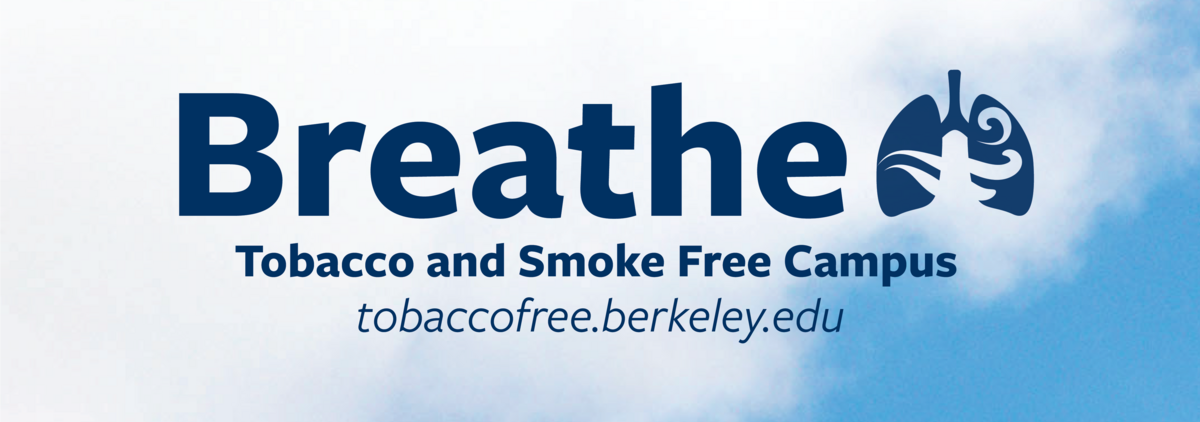
Tobacco and Smoke Free Campus
Know the policy
Since January 1, 2014, the entire UC Berkeley campus is a smoke and tobacco-free environment.
The UC Office of the President charged all UC campuses to go smoke- and tobacco-free to save lives and improve the health of our community. The policy prohibits the use of tobacco, smokeless tobacco (e.g. moist snuff, chewing tobacco, snus), and unregulated nicotine products (e.g. “e-cigarettes”) at all indoor and outdoor spaces owned or leased by UC Berkeley.
The aim of this policy is to:
- Create a healthier environment for students, faculty, staff, and visitors;
- Support tobacco users who are trying to quit; and
- Reduce the number of new tobacco users by promoting the social norm of a tobacco-free environment.
Read more:
- Full policy from the UC Office of the President
- Other resources from UCOP: FAQs, Fact Sheet, Quick Facts, Talking Points
- California Government Code
Learn the boundaries
Tobacco-Free Map

- Yellow Areas: City of Berkeley Smoke-Free Zones. Smoking is prohibited in the City of Berkeley commercial zones (including sidewalks).
- Dark Blue Areas: University of California, Berkeley Tobacco-Free Zones. Tobacco use is prohibited on all UC-owned or leased property.
- Light Blue Areas: Lawrence Berkeley National Laboratory. Learn more about Smoking at the Lab.
This map was created with the support and services of the Geospatial Innovation Facility (GIF) at UC Berkeley's College of Natural Resources.
Promote the message
Support a Smoke-Free campus by integrating messages and practices into the communities you are a part of.
Post Breathe materials
- Download Breathe campaign graphics and 1) Post in your office or campus residence, 2) Post at known smoking hotspots and building entrances, 3) Add to your website with a hyperlink to this site, 4) Upload as the wallpaper or screen saver on your personal or departmental devices.
- Affix "Thank you for not smoking here" decals (6"x8"), especially to cover outdated "no smoking" signage (email hpromo@berkeley.edu to request).
Influence your community
- Reference the Tobacco-Free policy in orientations for new members/staff.
- Organize a cigarette butt pick-up for the area outside your building.
- Discuss how to create a healthier environment within your community, and include smoking-related issues as part of that.
- Use one of UCOP's sample communications to deliver a proactive message to your staff/community members.
Talk to individuals
- Reach out to offer non-judgmental support to community members who might be trying to quit smoking.
- Respectfully let people know when they are in violation of the Smoke-Free policy.
Say Something
If someone is smoking on UC property, feel free to say something. When you let someone know that their behavior has an impact on you in a respectful manner, you may be able to influence them to make a change.
You may yield better results by requesting that the smoker modify their behavior (could you kindly move to location X?) rather than criticizing their choice to smoke, describing the negative health effects of smoking, or citing campus policies.
- "Excuse me, may I make a request? I'm working on keeping myself healthy lately, and I've noticed that I'm especially sensitive to smoke. Would you be willing to smoke somewhere else or put out your cigarette for the time being?"
- "Hello, I realize you wouldn't know this, but I have asthma/allergies and I would be really appreciative if you could smoke in a different location."
- "I don't like to be around cigarette smoke. I'll wait for you over here."
It may help to practice in advance how you would say something to different people (e.g. classmate, co-worker, stranger, etc.).
You can give this "thank you for not smoking" card to people who are smoking/vaping on campus. Print, or contact hpromo@berkeley.edu for pre-printed cards.
Did you know? Facts about Cigarette Butts and Smoke
- Most cigarette filters, the part that looks like white cotton, are actually made of plastic fibers (cellulose acetate) which can take up to 10 years to decompose!
- Toxic compounds in cigarette butts can include formaldehyde, nicotine, arsenic, lead, copper, chromium, cadmium, and a variety of polyaromatic hydrocarbons (PAHs).
- Butt waste is everywhere: 99% of the 360 billion cigarettes sold have cellulose acetate (plastic) filters; at least one-third of those – 120 billion – are discarded into the environment. Washed into rivers, lakes, and the ocean, and eaten by birds, animals, and fish, they are the most littered item in the U.S. and the world.
- Butt waste is not biodegradable: Filters are non-biodegradable, and while ultraviolet rays from the sun will eventually break them into smaller pieces, the toxic material never disappears.
- Smoking-related debris is 1/3 or more of all debris found on U.S. beaches and in rivers and streams.
- Cigarette butts leach organic chemicals and heavy metals into the environment that are toxic to fresh and salt-water fish.
- Cigarette butts make up 34 percent of the total litter collected in California.
- Cigarette waste is a significant contributor to storm drain trash.
- Discarded cigarette butts have been linked to wildfires, which destroy wildlife, vegetation and structures.
- California public agencies spend more than $41 million annually on litter cleanup.
- City of Berkeley: Tobacco litter is toxic to our environment, learn how to reduce the impact (Published: May 17, 2021, Last Updated: January 12, 2022)
- East Bay Times: Berkeley officials ask public to help reduce tobacco litter (May 19, 2021)
- City of Berkeley, State Tobacco Prevention Program (STPP) Overview (December 14, 2021)